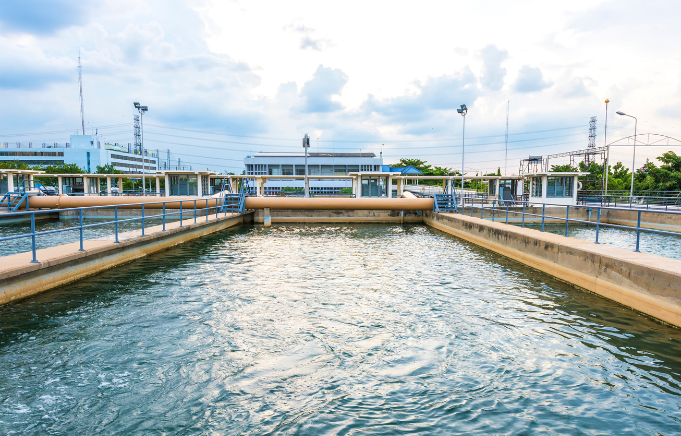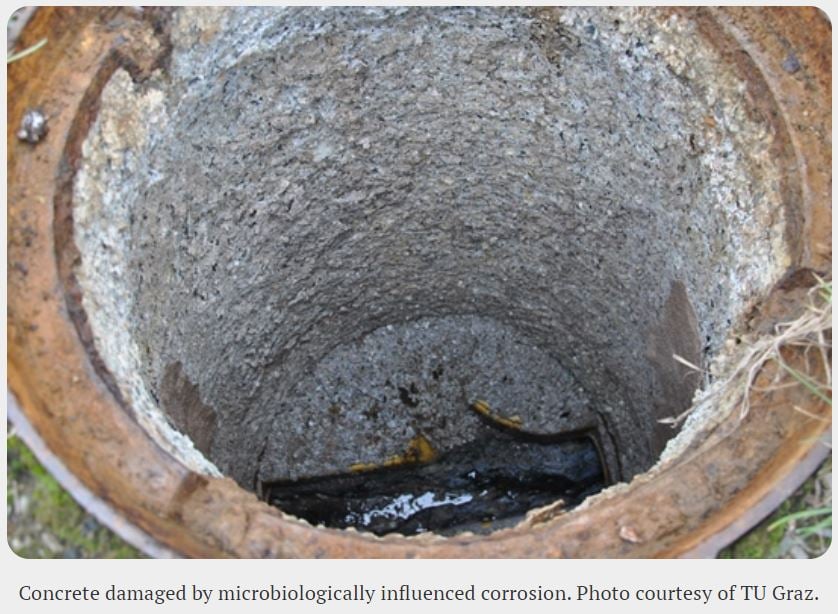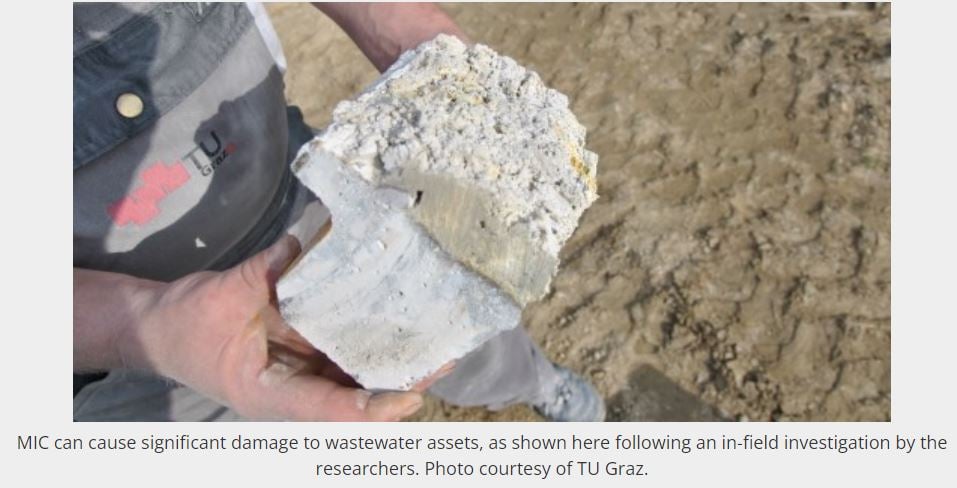Geopolymer Solution for Sulfuric Acid Corrosion at Wastewater Plants
March 31, 2023 •Corrosion CONTROLLED, Corrosion Essentials, Coatings

 Researchers from the Graz University of Technology (TU Graz) (Graz, Austria) believe geopolymer-based concrete (GPC) could offer superior protection against microbiologically influenced corrosion (MIC) for wastewater infrastructure relative to traditional ordinary Portland cement (OPC).
Researchers from the Graz University of Technology (TU Graz) (Graz, Austria) believe geopolymer-based concrete (GPC) could offer superior protection against microbiologically influenced corrosion (MIC) for wastewater infrastructure relative to traditional ordinary Portland cement (OPC).
According to the researchers, the geopolymer concretes offer superior resistance to acids, abrasions, and are less permeable than OPC-based materials, which are formed via cement hydration reactions. These calcium-rich hydration products are generally acid dissolvable, the researchers explain, thus making OPC prone to corrosion from acid attack.
“[MIC] often corrodes the conventional types of concrete used in wastewater treatment plants at a rate of 1 cm or more per year,” says Cyrill Grengg, a professor at TU Graz’s Institute of Applied Geosciences and a leader of the research team.1 “Accordingly, the concrete elements can be destroyed in a matter of only a few years, causing significant damage to wastewater systems. Closing the manhole covers and looking the other way is not the answer.”
They say their research shows that concrete made from geopolymers can have a greater lifespan than conventional concretes, thus extending the service life of wastewater assets.
Acid Attack Process in OPC
With OPC, microbial-induced acid corrosion in wastewater treatment facilities usually results from a sequence of biogenic sulfate reduction reactions, followed by reoxidation. Initially, the researchers explain, sulfate in pressurized pipelines or standing water is reduced by bacteria under oxygen-free conditions, thus forming hydrogen sulfide (H2S).
 From there, the H2S gas escapes into the sewer air and diffuses into sewer pipes and manholes. Autotrophic bacteria on the walls of the concrete then oxidize the H2S into sulfuric acid (H2SO4), which reacts with the concrete’s construction elements.
From there, the H2S gas escapes into the sewer air and diffuses into sewer pipes and manholes. Autotrophic bacteria on the walls of the concrete then oxidize the H2S into sulfuric acid (H2SO4), which reacts with the concrete’s construction elements.
“This leads to the vigorous formation of a biofilm on the surface of the concrete, a reduction of the pH value to below two,” says Günther Koraimann, a research team leader and professor at Tu Graz’s Institute of Molecular Biosciences. “In other words, [it is] highly acidic, and [leads to] extensive formation of new minerals, mainly in the form of gypsum. The combination of these processes results in the rapid destruction of the concrete.”
The researchers investigated the damage from MIC on traditional OPC assets through a series of in-field tests before comparing their statistical results to laboratory findings using geopolymers.
Advantages of Geopolymer Technology
In contrast to OPC, which is formed through hydration reactions, GPC is produced through the polycondensation of aluminosilicates. In this ion-exchange reaction process, materials like blast furnace slag, fly ash, or metakaolin are mixed with alkaline reagent solutions such as sodium- or potassium-soluble silicates to form a hardened, concrete-like texture. These geopolymer materials also offer a lower carbon footprint, potentially making them a “greener” alternative.
According to the researchers, the framework vacancies formed by the dissolution of aluminum are mostly reoccupied by the silicates. This results in an amorphous, highly siliceous framework that is relatively hard but brittle. This undissolved corroded layer can effectively inhibit the process of further corrosion by acting as a barrier to the transport of acid protons.
“Thus, compared to the neutralization capacity achieved by dissolution of hydration products, the permeability of the acidified [geopolymer] layers governs the rate of further ingress of acids,” the researchers write. In essence, the microorganisms that trigger the initial oxidation process in OPC corrosion cases and the formation of H2SO4 are unable to settle on the surface, the researchers say.
The alkali-activated specimens produce a layer of aluminosilicate gel, which studies have shown remains in place even after decalcification and offers chemical stability even at a low pH, they explain. X-ray diffraction (XRD), electron microscopy, and mechanical tests have been conducted on the acid resistance of a metakaolin material exposed to 0.01 M of hydrochloric acid (HCl) for 28 days, finding that the network structure remained practically intact while still showing excellent binding properties.
The researchers believe the addition of antimicrobial cation additives could further help in reducing bacterial colonization, though they acknowledge more research is needed.
Further Testing Needed
Going forward, the researchers say more thermodynamic data are needed on the performance of geopolymer concretes in the field before commercial advances can be made on the technology. For example, in the process they described, large variations of aluminum and silicon content are often seen—and researchers would like more data on the results of the varying compositions.
 “Lack of data on durability performances and standardization makes the field use of GPC difficult,” the researchers explain.
“Lack of data on durability performances and standardization makes the field use of GPC difficult,” the researchers explain.
The cation exchange property of geopolymers can also have a negative effect, they explain, such as having alkalis leach out from the geopolymer materials to form alkali sulfides in MIC environments on the concrete surface. This process is known as efflorescence.
The leaching of alkalis also lowers the pH inside the geopolymer, which researchers say could lead to corrosion initiation of the reinforcing steel bar. As a result, they believe new design strategies may be needed to reduce the amounts of alkali activator solutions as well as water content needed to produce denser microstructures. The shrinkage and creep of geopolymer materials is also underexplored, the researchers say, adding that it is another important topic worthy of further analysis.
Nonetheless, even considering the relative uncertainty with the GPC process, the researchers believe the vulnerability of traditional concrete to MIC makes further research a priority.
“While the overall process mechanisms and environmental parameters responsible for MIC are fairly well understood, to date, no commercially available concrete can satisfactorily withstand the adverse conditions in such aggressive environments over its projected operating life,” they write. “Accordingly, further research should focus on how to constrain concrete-microorganism interactions.”
Source: TU Graz, www.tugraz.at/en. Contact Cyrill Grengg, TU Graz—email: cyrill.grengg@tugraz.at.
Reference
1 “Combating Sulfuric Acid Corrosion at Wastewater Plants: Graz Scientists Develop New Solution,” TU Graz News, Feb. 22, 2018, https://www.tugraz.at/en/tu-graz/services/news-stories/tu-graz-news/singleview/article/grazer-loesung-gegen-schwefelsaeureangriff-auf-abwasseranlagen/ (March 19, 2018).
This article by Ben DuBose was originally published online for Materials Performance Magazine. Republished with permission.
Check out AMPP's Corrosion in the Water and Wastewater Industry articles, related courses and certifications. Keep reading to find out more.
More Industry Resources
Forefront Innovation Series
(Formerly the Corrosion Technical Series)
Wastewater Corrosion: A Primer on Current Best Practices, Specifications, and Future State
April 25-26, 2023
This event focuses on corrosion detection and mitigation in the wastewater industry. The speakers will share problem-solving strategies on identifying corrosion, coating selection, coating application, inspection, and real-life case studies in wastewater environments.
Event details | Register | 6 PDH
Featured Webcast: A Water Department's Proactive Approach to Infrastructure and Reliability | Available On-Demand | Duration: 60 Minutes
Episode Two of the Flint Phenomenon series continues the roundtable discussion surrounding the water crisis in Flint, Michigan. In this chat, panelists explore the science behind the problem while evaluating the difficulty in monitoring lead in water systems; the use of corrosion inhibitors and water filters; the changing standards of lead in metals and drinking water; and how Flint is doing today. Panelists include John Scully, Technical Editor in Chief of CORROSION journal; Virginia Tech’s Marc Edwards, who led the team that collected the water samples; and the U.S. Environmental Protection Agency’s Darren Lytle.
The Power of Everyday Heroes
Get a glimpse into the careers of some of our members as they talk about their roles in the industry, how they got started, and why their careers are important in keeping the world safe. Watch for more AMPP Stories to come and start thinking about what your story will be. Your AMPP Career Pathway begins with over 115 courses and certifications that could change your life by joining a global community of professionals and skilled workers dedicated to materials protection through the advancement of corrosion control and protective coatings. The future of AMPP begins with you!
NACE and SSPC are now AMPP, The Association for Materials Protection and Performance. Join AMPP Today!
Get Updates
Featured Articles
Categories
- 2024 Olympics (1)
- 2024 Water Resource Development Act (1)
- Abrasive Blasting (1)
- Advanced coating materials (9)
- advanced coatings (1)
- Advanced Corrosion Control in Oil and Gas Industry (2)
- Advocacy (3)
- AI (2)
- Aircraft (1)
- Alkanization (1)
- AMPP (4)
- AMPP Annual Conference + Expo (5)
- ampp awards (1)
- ampp certification (2)
- Ampp Chapters (1)
- AMPP conference (1)
- AMPP logo (1)
- Ampp Membership (2)
- Ampp Standards (3)
- ampp training (2)
- Amusement parks (4)
- Architectural (1)
- Architectural Coatings (2)
- argonne national laboratory (1)
- Artificial Intelligence (1)
- Asset integrity (12)
- Asset maintenance (3)
- Asset Protection (1)
- awards (3)
- B2B Marketing (1)
- Bim Software (1)
- Biodeterioration of materials (5)
- Biofouling (4)
- Blasting (1)
- Bridges (4)
- career advancement (3)
- career development (2)
- cathodic protection (2)
- Cathodic Protection-CP (16)
- Ceramic epoxies (1)
- Certification (3)
- certification study guide (1)
- Chemical Injection (1)
- CIP (1)
- Civil Engineering (1)
- clean energy (1)
- Coating inspector (2)
- coating inspector job roles (1)
- Coating inspector jobs (2)
- Coating inspector program (2)
- Coatings (18)
- Coatings Application (3)
- coatings certification (1)
- Coatings failures (2)
- Coatings Industry (2)
- coatings inspection (1)
- Coatings inspector (2)
- Coatings measurement and inspection (9)
- coatings project management (1)
- Coatings Systems (1)
- Cold stress (1)
- Concrete (13)
- Concrete corrosion (1)
- concrete cracking (1)
- Conference and Events (2)
- Corrosion (26)
- Corrosion Basics (5)
- corrosion certification (1)
- Corrosion Control (17)
- Corrosion Control and Management (23)
- Corrosion detection (1)
- corrosion engineering (1)
- Corrosion Essentials (20)
- Corrosion Inspection (1)
- Corrosion Management (1)
- Corrosion Meaning (1)
- corrosion mitigation (1)
- corrosion of steel (1)
- corrosion policy (1)
- Corrosion Prevention (13)
- corrosion resistance (1)
- corrosion resources (1)
- Corrosion Under Insulation (2)
- cost of corrosion (1)
- Crevice Corrosion (1)
- Cui (2)
- Data Monitoring (1)
- decarbonization (1)
- defense infrastructure (1)
- Department of Defense (4)
- Deposition corrosion (1)
- Dissimilar Metal Corrosion (1)
- Dissolved gases (1)
- DoD (3)
- Education (2)
- EMERG (1)
- Energy industry (9)
- entertainment industry (1)
- Epoxy (3)
- exam preparation (1)
- FBE Application (1)
- FBE Inspection (1)
- Fireproofing (1)
- Flexible coatings (2)
- Flint, Michigan (1)
- Fluoropolymer coating (3)
- Forms of Corrosion (4)
- Freshwater salinization (1)
- Fusion-bonded epoxy (1)
- Galvanic (1)
- Galvanic Corrosion (4)
- General Corrosion (4)
- General Tips (1)
- Global supply chain resilience (1)
- glossary (1)
- Hand tools (1)
- honoree night (1)
- Industrial Application (3)
- Industrial Safety (3)
- Industry Best Practices (1)
- Industry Standards (2)
- Infrared Thermography (1)
- infrastructure (4)
- Infrastructure Durability (1)
- Inspection (1)
- integrity management (1)
- Intergranular Corrosion (1)
- International Maritime Organization (IMO) (1)
- Intumescent Coatings (1)
- key note speaker (1)
- leader (1)
- Machine Learning (2)
- Maintenance (2)
- Maintenance Best Practices (1)
- Maritime Coatings (11)
- Maritime industry (12)
- Maritime infrastructure (1)
- Master Painters Institute (2)
- material protection (1)
- materials performance (1)
- materials science (1)
- Membership (2)
- Membership Benefits (2)
- Michio Kaku (1)
- Microbiological forms (1)
- Microbiologically influenced corrosion-MIC (11)
- Military (2)
- Mineral constituents (1)
- MnDOT (1)
- MPI (3)
- mpi awards (1)
- mpi champion awards (1)
- mpi training (1)
- MPI Update (1)
- MR21506-2025 (1)
- National Defense Authorization Act (1)
- national security (1)
- Naval readiness (1)
- Navy (1)
- nickel-based alloys (1)
- Non-Destructive Testing (1)
- nuclear (1)
- nuclear Materials (1)
- nuclear reactor technology (1)
- Oil and Gas (2)
- Oil Fields (1)
- Organic matter (1)
- Oxgen (1)
- Paint and Protective coatings (32)
- Paint specification (1)
- pcs certification (1)
- Personal Protective Equipment (3)
- Petrochemical Plant Fireproofing Methods (1)
- Petrochemical Plants (1)
- Pipeline (2)
- Pitting Corrosion (2)
- Pitting Detection (1)
- Polymer-Based Coatings (1)
- Power plant (1)
- Power tools (1)
- PPE (3)
- Print Advertising (1)
- Print Marketing Strategy (1)
- professional certification (2)
- professional development (1)
- Protecting oceans (1)
- Protective Coatings (7)
- protective coatings industry (1)
- protective coatings specialist (1)
- quality assurance (1)
- radiation-resistant materials (1)
- Real-Time Corrosion Monitoring in Oil Fields (1)
- Rebar Corrosion (2)
- rectifier (1)
- Reliability (1)
- Remote monitoring and drones (4)
- Repaint (1)
- Restoration (1)
- ride maintenance (1)
- Risk-Based Inspection (1)
- Road deicers (1)
- Roads and bridges (1)
- Roller coaster (1)
- Rust (1)
- sacrificial anodes (1)
- Safety (5)
- Safety Standards (3)
- Salt pollution (1)
- Sensors (1)
- service awards (2)
- Ship Coatings (9)
- Shiptanks (1)
- Solvent-free coatings (1)
- Standards (10)
- Standards Committees (2)
- Steel (8)
- Steel Reinforcement (2)
- Stress Corrosion Cracking (1)
- Structural Steel (1)
- study tips (1)
- Surface Preparation (13)
- Sustainability (2)
- Sustainability and corrosion (7)
- terminology (1)
- Tools (1)
- Turbine (1)
- Types of Corrosion (1)
- Ultrasonic Testing (1)
- Uniform Corrosion (1)
- us army core of engineers (1)
- Wastewater Systems (1)
- Water crisis (1)
- Water pipe corrosion (1)
- Water quality (1)
- Water tank coatings (5)
- Water/treatment infrastructure (20)
- Waterway salinity (1)
- What Is Corrosion (1)
- Workforce development (1)
- WRDA (1)

.png?width=722&height=120&name=CROSS%20PROMO%20BANNER%20TEMPLATE%20%20(1).png)



